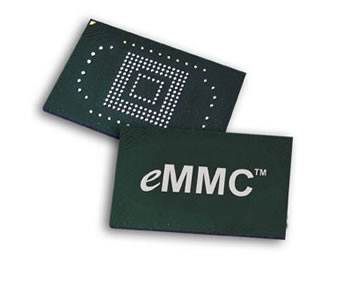Difference between eMMC and SSD
Key Difference: eMMC stands for Embedded MultiMediaCard, while SSD stands for Solid-state drive or Solid-state disk. The primary difference between the two is that eMMC is a type of flash storage based on the MMC standard, while SSD is a type of Solid-state Storage.
 eMMC and SSD are two different types of memory storages. eMMC stands for Embedded MMC, while MMC stands for MultiMediaCard. It is a type of memory card standard that is commonly used for solid-state storage. SSD stands for Solid-state drive or Solid-state disk. The primary difference between the two is that eMMC is a type of flash storage based on the MMC standard, while SSD is a type of Solid-state Storage.
eMMC and SSD are two different types of memory storages. eMMC stands for Embedded MMC, while MMC stands for MultiMediaCard. It is a type of memory card standard that is commonly used for solid-state storage. SSD stands for Solid-state drive or Solid-state disk. The primary difference between the two is that eMMC is a type of flash storage based on the MMC standard, while SSD is a type of Solid-state Storage.
Both eMMC and SSD operated on the NAND principles, where the data is transferred through NAND gates. eMMC typically has only one NAND gate, while SSD tends to have more. Think of NAND gates as highways which allow the flow for traffic. If a city has only one highway in and out, it probably will be congested at all times, making the traffic move slowly. However, if there are more highways then the traffic gets distributed between them, allowing the cars, i.e. data to move faster.
This is what happens between eMMC and SSD. Typically, SSD has a much faster read-write speed as compared to eMMC. The top speed of SSD is about 1500 MB/s, whereas for eMMC the top speed is just 400 MB/s. However, this does of course vary with the model and type. Hence, eMMC and SSD are mostly comparable in their increased durability and energy-efficiency, but not in performance.
 The also differ in the amount of storage space each one provides. eMMC offers much less onboard storage than SSD. Typically, eMMC is offered in 32GB and 64GB variants, though other sizes are available, such as 128GB. SSD, on the other hand, typically comes in 128GB, 256GB, 320GB, and 512GB variants. Hence, to combat this, eMMCs are often paired with cloud storage, i.e. files are stored on a remote server, whereas SSD don’t need to be, but can be if the user needs extra storage.
The also differ in the amount of storage space each one provides. eMMC offers much less onboard storage than SSD. Typically, eMMC is offered in 32GB and 64GB variants, though other sizes are available, such as 128GB. SSD, on the other hand, typically comes in 128GB, 256GB, 320GB, and 512GB variants. Hence, to combat this, eMMCs are often paired with cloud storage, i.e. files are stored on a remote server, whereas SSD don’t need to be, but can be if the user needs extra storage.
While SSD drives are usually connected to the motherboard via the SATA interface, eMMC are often directly soldered onto the motherboard, similar to the microprocessor and other integrated circuits. eMMC consists of both flash memory and a flash memory controller integrated on the same silicon die; though SSDs also come with a flash memory controller that bridges the NAND memory components to the host computer, commonly SATA.
Even though the cost of technology has been steadily dropping, SSD are still quite expensive. Consumer level SSD are up to four times more expensive than HDDs, which in turn are quite expensive than eMMCs. This is why SSDs are rarely used in consumer level electronics. Most manufacturers prefer to use HDDs, but quite a few now opt to use eMMCs, especially in low end, entry level consumer devices, which can work with eMMC’s limitations while also keeping costs down.
Comparison between eMMC and SSD:
|
|
eMMC |
SSD |
|
Stands for |
Embedded MultiMediaCard |
Solid-state drive or Solid-state disk |
|
Technical Description |
Flash memory plus controller in a small ball grid array (BGA) IC package for use in circuit boards as an embedded non-volatile memory system |
Uses integrated circuit assemblies as memory to store data persistently |
|
Type of |
Storage |
Storage |
|
Storage Type |
Flash Storage |
Solid-state Storage |
|
Functions |
Used as a temporary storage medium for a portable device |
Used as a permanent storage medium |
|
Used in |
Smartphones, tablets, entry-level laptops, 2-in-1 computers, digital audio players, digital cameras, as well as removable storage such as SD cards. |
Computers and laptops |
|
Small File Storage |
Faster for small file storage and retrieval |
Slower for small file storage and retrieval |
|
Large File Storage |
Slower for large file storage and retrieval |
Faster for large file storage and retrieval |
|
Transfer Rate |
Maximum speed is 400 MB/s. |
In consumer products the maximum transfer rate typically ranges from about 200 MB/s to 1500 MB/s, depending on the disk. |
Reference: Wikipedia (eMMC and SSD), Laptoping, How to Geek, Datalight Image Courtesy: linkedin.com, technomag.co.zw









Add new comment